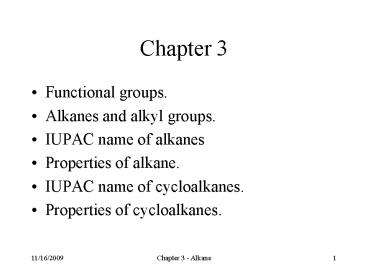Functional groups' - PowerPoint PPT Presentation
1 / 32
Title:
Functional groups'
Description:
Hydrocarbons, Aliphatic, Paraffins. Saturated - CnH2n 2. Straight, open, normal, and branched chain. Constitutional Isomers. Naming: methane to decane ... – PowerPoint PPT presentation
Number of Views:405
Avg rating:3.0/5.0
Title: Functional groups'
1
Chapter 3
- Functional groups.
- Alkanes and alkyl groups.
- IUPAC name of alkanes
- Properties of alkane.
- IUPAC name of cycloalkanes.
- Properties of cycloalkanes.
2
Functional groups
alkane
alkene
alkyne
arene
halide
3
Functional group
carbonyl
water
aldehyde
H
alcohol
ketone
ether
acid
thiol
ester
sulfide
amide
amine
4
Functional group
and others, see page 76 Table 3.1
5
Chapter 3
- Functional groups.
- Alkane and alkyl groups.
- IUPAC name of alkanes
- Properties of alkane.
- IUPAC name of cycloalkanes.
- Properties of cycloalkanes.
6
Alkanes
- Hydrocarbons, Aliphatic, Paraffins
- Saturated - CnH2n2
- Straight, open, normal, and branched chain
- Constitutional Isomers
- Naming methane to decane
7
Alkanes - Straight, open, normal, and branched
chain
C3H8
C4H10
branched
C5H12
C6H14
C7H16
Straight, open, normal
8
Alkanes - Constitutional Isomers
Graph theory - 1874
See Table 3.2 on p82
C6H14
6
5
4
3
9
Alkanes - Names of straight chain
Table 3.3 on p83 - Methane - Decane
10
Alkyl groups
- Partial structure of alkane - H atom removed.
- Unstable.
- Name - replacing -ane by -yl.
- 1o, 2o, 3o, 4o.
11
Alkyl groups
- -CH3 methyl
- -CH2CH3 ethyl
- -CH2CH2CH3 propyl
- -CH2CH2CH2CH3 butyl
- -CH(CH3)2 iso-propyl
- -C(CH3)3 tert-butyl
- see Tables 3.4 (p 84) Figure 3.3 (p 85).
12
Alkyl groups - 1o, 2o, 3o, 4o
2o
3o
1o
4o
13
Chapter 3
- Functional groups.
- Alkanes and alkyl groups.
- IUPAC name of alkanes
- Properties of alkane.
- IUPAC name of cycloalkanes.
- Properties of cycloalkanes.
14
IUPAC Name of alkanes
- Find the parent hydrocarbon (i.e. the longest
chain). - Number the atoms in the main chain.
- Identify and number the substituents.
- Write the name in a single word.
- Name a complex substituent just as though it were
itself a compound.
15
IUPAC Name of alkanes
-hexane
2,2,3,3-Tetramethyl
16
Chapter 3
- Functional groups.
- Alkanes and alkyl groups.
- IUPAC name of alkanes
- Properties of alkane.
- IUPAC name of cycloalkanes.
- Properties of cycloalkanes.
17
Alkane Properties
- Non-polar.
- Low energy barrier rotation.
- Chemically inert.
- CnH2n2 (3n1)/2O2(g) ? nCO2(g) (n1)H2O(g)
- CH4 Cl2
18
Alkane Properties - non-polar
19
(No Transcript)
20
Alkane Properties - Low energy barrier rotation
21
Alkane Properties - reactions
Chemically inert, except ...
22
Chapter 3
- Functional groups.
- Alkanes and alkyl groups.
- IUPAC name of alkanes
- Properties of alkane.
- IUPAC name of cycloalkanes.
- Properties of cycloalkanes.
23
Cycloalkane
- Alicyclic alkane.
- CnH2n
- Less flexible than straight chain (C3-C7).
- Non-polar.
- Naming.
- Stereoisomers.
24
Alicyclic alkane
cyclopropane
cyclobutane
cyclopentane
cyclohexane
cyclohexane
cyclohexane
cycloheptane
cyclooctane
25
Less flexible
n 11
n 3
cyclopropane
cycloundecane
26
IUPAC Name of cycloalkane
- Find the parent.
- Number the substituents
1,4-Dimethylcyclohexane
3-Cyclobutylpentane
1- Methy-3-propylcyclopentane
1-Bromo-4-ethylcyclodecane
1-tert-butyl-2-methylcyclohexane
4-Bromo-1-tert-butyl-2-methylcycloheptane
27
Bicycloalkane
Bridge
6
4
Bridgehead carbon
3
5
1
2
28
Stereoisomers of cycloalkane
Constitutional isomers
Stereoisomers
29
Stereoisomers of cycloalkane
30
Stereoisomers of cycloalkane
- Identify the carbon as 1o, 2o, 3o, 4o.
- Give the IUPAC name
31
Stereoisomers of cycloalkane
Which stereoisomer is energetically more stable?
32
Chapter 3
- Functional groups.
- Alkanes and alkyl groups.
- IUPAC name of alkanes
- Properties of alkane.
- IUPAC name of cycloalkanes.
- Properties of cycloalkanes.































